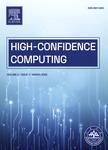Data-driven approach to designing a BCI-integrated smart wheelchair through cost-benefit analysis
作者机构:Indira Gandhi Institute of Technology Sarang(Nodal Center of Utkal University)Odisha 759146India
出 版 物:《高置信计算(英文)》 (High-Confidence Computing)
年 卷 期:2023年第3卷第2期
页 面:1-9页
核心收录:
学科分类:0810[工学-信息与通信工程] 12[管理学] 1201[管理学-管理科学与工程(可授管理学、工学学位)] 0808[工学-电气工程] 0839[工学-网络空间安全] 081104[工学-模式识别与智能系统] 08[工学] 0835[工学-软件工程] 0701[理学-数学] 0811[工学-控制科学与工程] 0812[工学-计算机科学与技术(可授工学、理学学位)]
主 题:EEG Attention Cost-benefit analysis Machine learning Meditation Smart wheelchair
摘 要:A smart wheelchair provides mobility assistance to persons with motor disabilities by processing sensory inputs from the *** involves accurately collecting inputs from the user during various movement activities and using them to determine their intended *** smart wheelchairs work by collecting brain signals in the form of electroencephalography(EEG)signals and by processing them into a quantized format to provide movement assistance to *** systems can be referred to as brain-computer interface(BCI)systems that work with EEG *** data from human beings in the form of brain signals through EEG,along with processing of those signals and ensuring the correctness of actions instigated by those brain signals involve a huge amount of *** this work,we carried out an experiment by taking 100 human subjects and recording their brain signals using a NeuroMax *** wheelchairs are constrained by design as the motion of those is limited either by manual operation or controlled by haptic sensors and *** main objective in this work was to design a wheelchair with better usability and control using machine learning-based knowledge,which is typically a data-driven ***,the proposed approach was designed to take inputs from human gestures and brain sensory activities to provide better usability to the *** attention meditation cost–benefit analysis(AMCBA)proposed in this paper aims to reduce the risk of inappropriate results and improve performance by considering various cost-benefit *** said classifier aims to improve the quality of emotion recognition by filtering features from EEG signals using methods of feature *** operation of the proposed method is described in two steps:in the first step,we assign weights to different channels for the extraction of spatial and temporal information from human *** second step presents the cost-benefit model to improve the accuracy t



